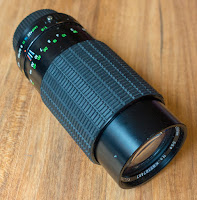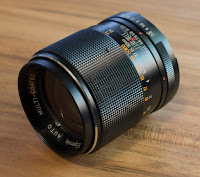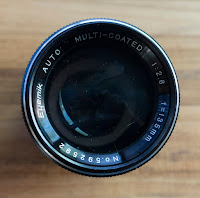I was very excited to test an auto focus lens on the electronic Viltrox adapter. In theory, the adapter should be able to auto-focus on any EF of EF-S mount lens. But practice and theory are not always the same ... And this lens proved that point. Although it made some focus noise, it was actually not moving the focus at all. Either the lens is not compatible, or the lens was damaged. But it did pass on all the EXIF data, and that was nice after shooting a few years with all manual lenses.
So the lens was tested in manual mode. And I did not find that a pleasant experience with this lens. The focus barrel range was short, so accurate focus was difficult resulting in many missed photo's.
Completely built from plastic, including the mount, it felt very cheap, although the rubber grip on the zoom barrel gave a good grip.
Image quality was disappointing with lack of focus, color fringing on the edges, and rather flat colors that were adjustable in Lightroom. Not to surprising as Tamron lenses of this age do not have the best reputations, especially the cheaper zoom lenses such as this one.
I do understand that by going aspherical, quality was sacrificed for a lower cost, and I also understand that the 77D model was one of the early models. Maybe the later models saw some improvements.
You could consider this a cheap walk-around lens for a rainy day where you do not care if the lens survives the shoot, but my conclusion is that I'm going to pass on other cheap Tamron lenses. There are plenty better lenses to find at this price level.
Lens Specification:
Focal Length: 28-80mm
Maximum Aperture: F3.5-5.6
Minimum Aperture: 22
Image Format: 35mm
Lens Mount: EF
Optics: 7 elements, 7 groups?
Blades: 6?
Focusing: Auto and Manual
Minimum Focus: 70mm
Filter Size: 58mm
Weight: 247g
Length: 77-90mm
Production: +/- 1995
Serial Number: 100965
Made in: Japan
Company:
This company was founded in Japan by Mr. Takeyuki Arai in 1950 under the name of Taisei optical Equipment Manufacturing. In 1957, it developed is first lens, a 135mm F/4.5 and introduced the T-Mount, allowing lenses to be used on different mounts by just swapping out the T-adapter. The less popular Adaptall mount was released in 1979 and was able to mechanically communicate aperture information.
In 1958, the brand of Tamron was registered, named after the late designer of optical components, Uhyoue Tamura, who laid the foundations of the company's technical expertise.
Tamron is now owned for 11.38% by Sony, and is one of the few remaining independent lens manufacturers.
Aspherical:
The aspherical elements in the front group reduced the number of elements required, resulting in cheaper and lighter lenses.
AF:
Auto Focus capability
Adapter:
VILTROX Mount Adapter EF-NEX II
Cost: $40, used on eBay
This electronic adapter allows Canon EF and EF-S lenses to be mounted on Sony E-Mount APS-C format cameras. It is capable of providing Auto-Focus with more recent lenses (trial and error to find compatible lenses). The electronic connection, if used with a modern lens will be able to provide EXIF data such as shutter speed, aperture, focus length and ISO. As this is a glass-free adapter, you do get the crop factor when used with APS-C camera's such as the Sony a6000. Although a cheap adapter, it's solidly made, and provided a tight mount of the lens.
Samples:
 |
| 1/100 sec - f/8 - 30mm - ISO100 - Handheld |
 |
| 1/60 sec - f/8 - 30mm - ISO100 - Handheld |
 |
| 1/320 sec - f/7.1 - 32mm - ISO100 - Handheld |
 |
| 1/200 sec - f/7.1 - 30mm - ISO100 - Handheld |
 |
| 1/125 sec - f/18 - 28mm - ISO100 - Handheld |
 |
| 1/160 sec - f/4 - 30mm - ISO125 - Handheld |
Sources:


































